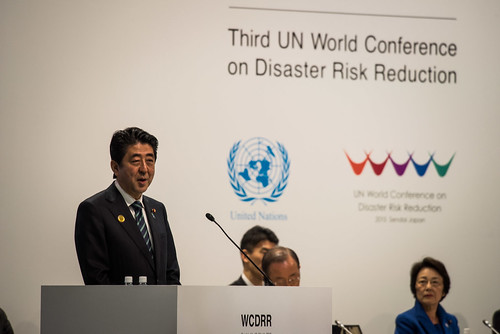第3屆聯合國世界防災會議(UN World Conference on Disaster Risk Reduction)上週落幕,與會國家同意採行新的防災框架,盼在2030年以前減低自然災害帶來的傷亡、遷移和破壞。
仙台減災綱領過關 日先投入40億美元基金
超過30小時的馬拉松式談判之後,這項致力於減低死亡和經濟損失的新全球計劃,終於達成共識,在193個與會國中,有186個國家的代表投下贊成票。
日本首相安倍晉三並承諾投入40億美元,以支持這項將於未來5年實施的《仙台減災綱領》仙台減災綱領(Sendai Framework for Disaster Risk Reduction),以加強開發中國家的災害風險降低力量。
安倍表示:「對於已開發和開中國家,降低災害風險是最重要的挑戰。而90%的災民集中在開發中國家,減災對這些國家特別重要。」
這項仙台基金將著重在發展防災基礎建設、促進全球與區域合作,及訓練4萬名政府官員與地方領導者,以帶領國家災害風險降低力量。
天災經損10年達1.3兆 大部分由亞洲承擔
10年前,印度海嘯之後,《兵庫行動綱領》(Hyogo Framework for Action)在上一屆全球降低災害風險會議中採行,而這項新協議將取代目前的行動綱領。
大多數這樣的災害發生在亞洲。根據聯合國資料,兵庫行動綱領減低了自然災害的直接衝擊人數近乎10億人。
然而在過去十年,災害已造成超過70萬人死亡、140萬人受傷,及2300萬人流離失所。總體而言,超過15億人受到災害某種程度的波及,以及全世界經濟損失突破1.3兆元。
未來15年在這項新協議下,將達成7項全球目標:
- 降低全球災害死亡率
- 降低衝擊人數
- 降低按照全球生產總值計算的經濟損失
- 降低重大基礎建設損害及基本服務中斷,如健康與教育
- 2020年以前增加具有國家與區域災害風險降低策略的國家數目
- 強化國際合作
- 增加複合災害預警系統的使用及災害風險資訊與評估
著眼未來 防災成果攸關永續發展
一項新研究指出,雖然不是不可能在2030年以前達成降低依全球生產總值計算的經濟損失,但這個目標可能還是困難的。
風險管理公司AIR Worldwide的一項災難模擬研究顯示,各國不可能降低目前每年2400億元等級的災害損失。AIR Worldwide資深副總裁Milan Simic博士表示:「這項研究告訴我們幾乎不可能降低現有的經濟損失等級。」
AIR Worldwide的研究建議開放經濟損失資料,包含土地利用與都市規劃等措施的成本效益分析,及風險轉移的推動。完整的全球研究將於6月發佈。
聯合國減災署領導人Margareta Wahlström表示,「未來15年,仙台減災綱領的實施需要強力的承諾與政治領導,並且攸關今年後續達成永續發展目標與氣候的未來協議。」
她說:「這項新減災綱領的採行開啟一個永續發展的重大新章節,概述明確目標與行動優先順序,將可持續地減低災害風險及生命、生存與健康的損失。」
來自芬蘭的大會首要委員會聯席大使Päivi Kairamo表示:「最後的優先考慮項目要求更有效的災害準備,及嵌入『建設得更好(build back better)』準則到恢復、復原和重建。這些將會是未來15年降低災害風險的方位。」
Death, injury, displacement and destruction following natural disasters could be reduced by 2030 under a new framework adopted by countries attending the 3rd UN World Conference on Disaster Risk Reduction, in Sendai.
As the conference wrapped its five-day meeting Wednesday after a marathon round of negotiations that continued for over 30 hours straight, representatives from 186 of the UN’s 193 Member States agreed on the new global disaster plan that aims to reduce deaths and economic losses.
Japanese Prime Minister Shinzo Abe pledged US$4 billion to support implementation of the “Sendai Cooperation Initiative for Disaster Risk Reduction” over the next four years to enhance the disaster risk reduction efforts of developing countries.
Prime Minister Abe said, “Disaster risk reduction is the most important challenge for both developed and developing countries. For developing countries in particular, where 90 percent of disaster victims are concentrated.”
The Sendai fund will focus on the development of disaster-proof infrastructure, the promotion of global and regional cooperation and the training of 40,000 government officials and local leaders to take the lead in national efforts for disaster risk reduction. Japan will make its expertise and knowledge available, said Abe.
The new agreement will take the place of the current Hyogo Framework for Action adopted 10 years ago at the last global disaster risk reduction conference after the Indian Ocean tsunami, which claimed 227,000 lives.
The Hyogo Framework for Action reduced the number of people directly affected by natural disasters in Asia, where most such disasters occur, by almost one billion, according to UN data.
Yet over the past decade, disasters have killed more that 700,000 people, injured 1.4 million, and left some 23 million homeless.
Overall, more than 1.5 billion people were in some way touched by disaster and worldwide economic losses topped $1.3 trillion.
Under the new agreement, the seven global targets to be achieved over the next 15 years are:
* – reduction in global disaster mortality;
* – reduction in numbers of affected people;
* – reduction in economic losses in relation to global GDP;
* – reduction in damage to critical infrastructure and disruption of basic services, such as health and education;
* – an increase in the number of countries with national and local disaster risk reduction strategies by 2020;
* – enhanced international cooperation;
* – increased access to multi-hazard early warning systems and disaster risk information and assessments.
The goal of reducing economic losses in relation to global GDP by 2030 may be difficult, if not impossible, to achieve, new research indicates.
A catastrophe modeling study from risk management firm AIR Worldwide showed it is unlikely countries can cut disaster losses from present levels of $240 billion a year.
“The study tells us that it is next to impossible to reduce existing levels of economic losses,” said Dr. Milan Simic, senior vice president of AIR Worldwide.
He views the current numbers as a baseline and context for improvement.
The AIR Worldwide study recommends making economic loss data more accessible, cost benefit analyses of measures such as land-use and urban planning, and the promotion of risk transfer. The full global study will be issued in July.
“Implementation of the Sendai Framework for Disaster Risk Reduction over the next 15 years will require strong commitment and political leadership and will be vital to the achievement of future agreements on sustainable development goals and climate later this year,” said Margareta Wahlström, who heads the UN Office for Disaster Risk Reduction.
“The adoption of this new framework for disaster risk reduction opens a major new chapter in sustainable development as it outlines clear targets and priorities for action which will lead to a substantial reduction of disaster risk and losses in lives, livelihoods and health,” said Wahlström, who also serves as the UN secretary-general’s special representative for disaster risk reduction.
The conference was attended by over 6,500 participants, including 2,800 government representatives from 187 governments.
The Public Forum had 143,000 visitors over the five days of the conference making it one of the largest UN gatherings ever held in Japan.
The conference was held in Sendai, which was devastated by the earthquake and tsunami on March 11, 2011 that touched off the disastrous nuclear meltdown at the nearby Fukushima Daiichi power plant.
“Japan’s special relationship with the global disaster risk reduction community has been strengthened by the outcome of this world conference,” said Conference President Eriko Yamatani, Japan’s minister of state for disaster management.
“Successful implementation of this new framework will mean a reduction of existing levels of disaster risk and avoidance of the creation of new risk,” she said.
The conference’s Main Committee Co-Chair Ambassador Päivi Kairamo of Finland, said, “A final priority calls for more effective disaster preparedness and embedding the ‘build back better’ principle into recovery, rehabilitation and reconstruction. These will be the four points of the disaster risk reduction compass for the next 15 years.”
※ 全文及圖片詳見:ENS






